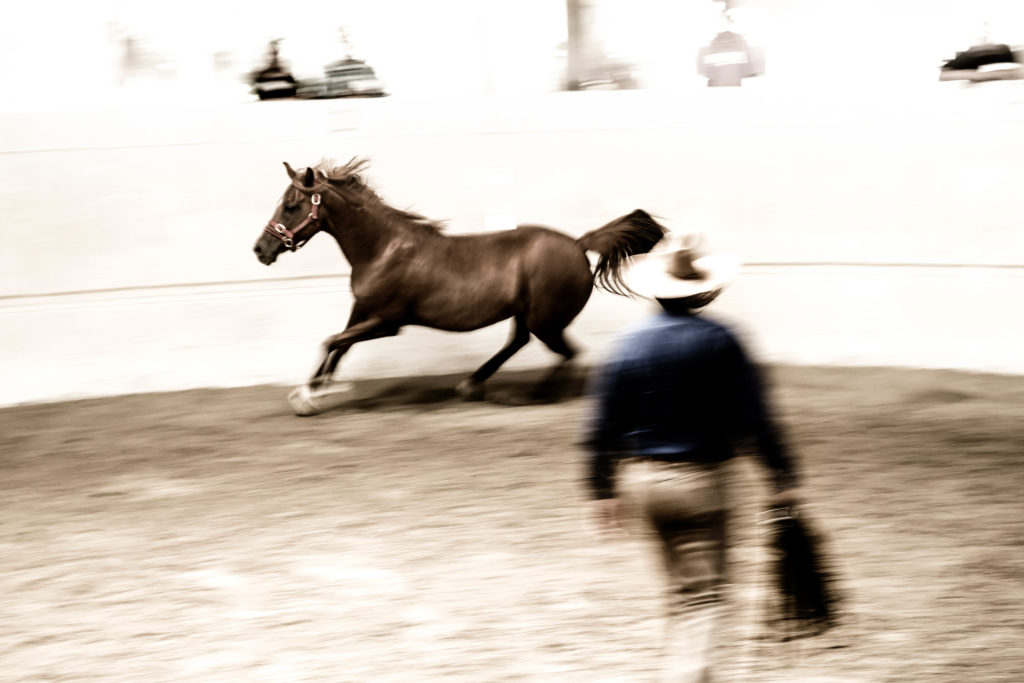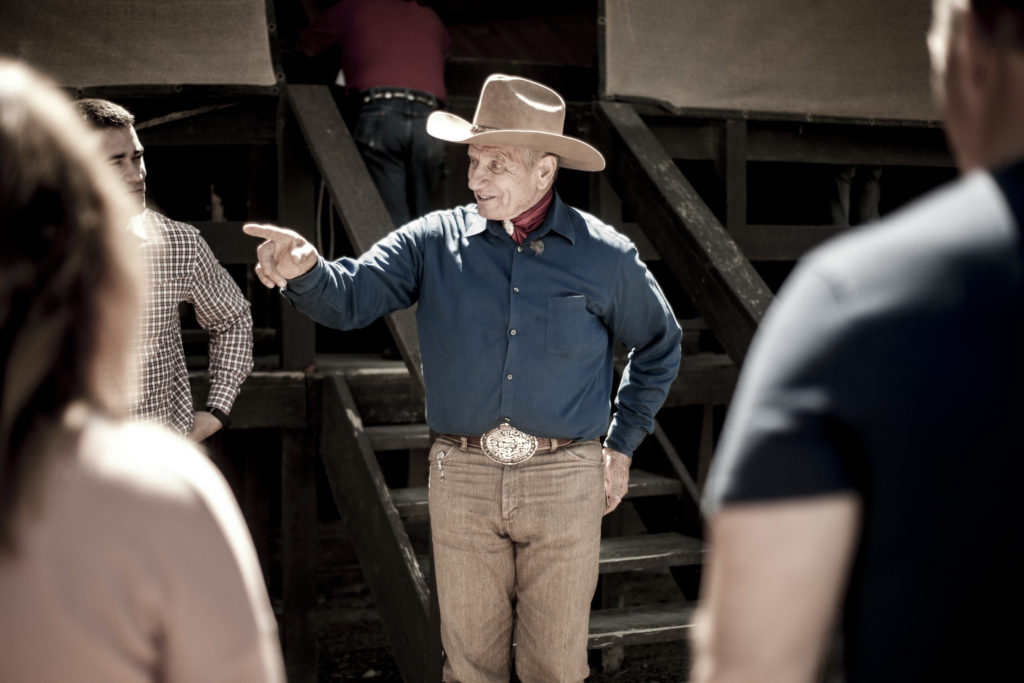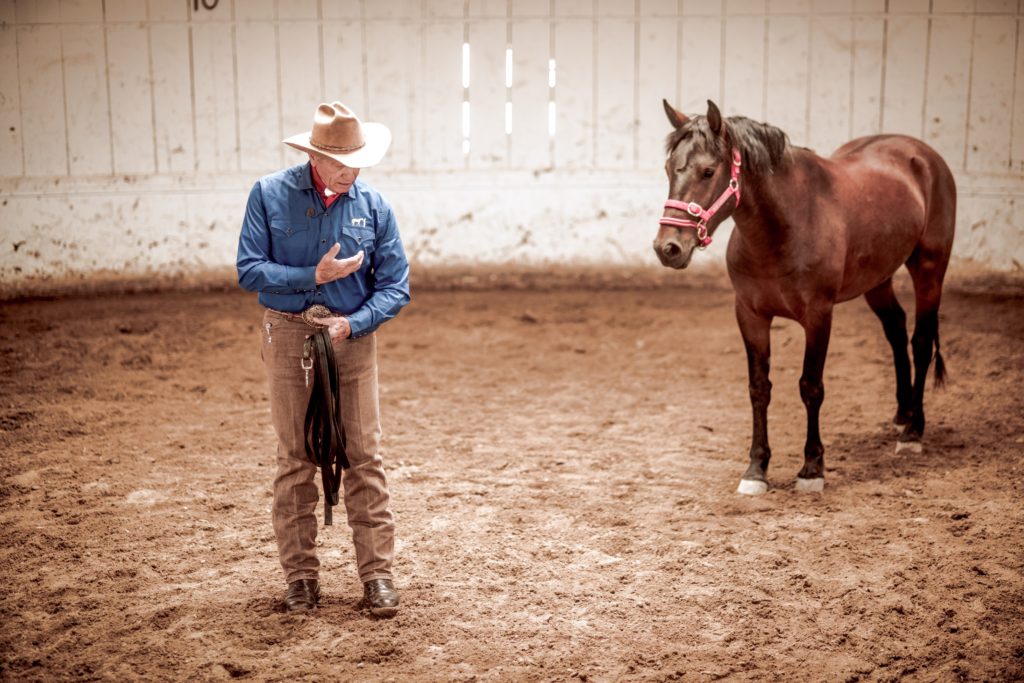
The Journal’s Icons of the West series continues in conversation with the Horse Whisperer himself.
Written by Jenn Thornton
Known throughout the world for his non-violent horse-training techniques, Monty Roberts has galvanized a global movement, bringing more folks around to his gentler, trust-based ways. Monty’s path is paved with personal experience. Born into the saddle, as he likes to say, this son of a horse trainer was expected to follow his father’s lead and, as such, was often violently disciplined through pain and force. In taking the opposite tack, Monty blazed new trails and earned legions of admirers. “I vowed to seek better methods for my horses,” he says. While “it is impossible for me to give an accurate count of the number of horses I have worked with in my life,” admits Monty, in 1996, associates of the late Queen Elizabeth II—a great horsewoman in her own right who championed Monty’s methods—estimated that total at 70,000 horses. “After that,” he adds, “we have a close count of about 3,500 horses in a 10-year span of time.” Today, having criss-crossed the globe training horses, conducting clinics and inspiring a new generation of trainers to take the reins, what is left to say? Well, when it’s straight from the Horse Whisperer’s mouth, plenty.

John Wayne had his horse, Dollar. You had Ginger. Talk about your first interaction with a horse. Was it with Ginger?
Ginger was my best friend, and he won my first competition for me. Jane Withers, an actress, presented me with the trophy and that opened my life into the world of motion-picture stunts as well as high-level competitions that took place globally and in many disciplines. This incident encouraged me to study horses top to bottom so I could become a friend and a communicator with the awesome animals that have embraced me and filled my life with joy. Horses have always been my best friends and they will be until my death.
When did you know that horses would be your life’s work?
I told myself that many times before the age of 10, but, of course, I didn’t know it would be true until I was about 14 or 15. This is when world championships came my way and the horses made it happen.
And now here you are, at the center of a remarkable evolution in horse training.
It is so fantastic to watch the evolution that is taking place in the world of horsemanship globally. We just returned from Brazil where more than 32,000 people sat to watch me work with an untrained horse.
In recent times I answered the call to speak at gatherings involving horsemanship and its changes. Today’s competitions leave me in awe of current trainers and their accomplishments. Never did I think I had all the answers, but since Ginger, I have accepted the fact that violence is never the answer in the training of horses for all disciplines. I have always felt that humans would come to realize the advantages of a non-violent association with these incredible creatures. There were times when I felt like giving up, but I’m certainly glad I didn’t.
While I was a Henry Ford, the trainers of today are creating far more than the Model T. In some disciplines, I believe they are up there in the Cadillac and the Maseratis of the world. This does not mean that all disciplines have reached the pinnacle of non-violent training, and even the best will probably reach higher goals.
Through your work, you’ve influenced broader culture, too. Is this intentional?
There is no such thing as a top-class horse trainer who is other than a top-class humanitarian, as well.

Your work has taken you all over the world. Tell me about your relationship with the late Queen.
Queen Elizabeth II stated categorically that my work was something that Her Majesty had prayed for her entire life. Her first riding instructor told her that horses did not require violence. He died when she was very young, and she was ignored every time she brought forth the subject. When Her Majesty saw my work with her horses in 1989, she sat me down, pointed a finger and said, “There has to be a book and you have to take this to the world.” I was startled by this, and it frightened me to think of the difficulties I would have with the world as we knew it at that time. Obviously, the Queen was right, and I failed to give the horsemen of the world credit for being able to observe a new way of treating horses and to see the vast improvement that non-violent training has come to enjoy. I now know that the world of horsemanship will end up way above me in the final analysis.
Without the Queen, there is a high probability that my work would have had a tiny effect on horse training. With Her Majesty’s influence, it went global. How lucky can one cowboy be to be knighted by the Queen and sent out into the world to change the course of all horse training?
Say more about your impact on the global equestrian community.
Taking my work to the world resulted in polo bringing its highest performers to visit me in California. They instantly changed their breaking procedures that were killing 52 percent of the horses by scientific review. I am told that not one horse has been killed in their breaking procedures since that time. The Gracida brothers and Adolfo Cambiaso have led the polo industry in the elimination of violence with the early stages of training their prospects. This is the most joyous experience I have had.
After all these years working with horses, do you still consider yourself a student?
Without any doubt I am still a student. While there was more rapid learning in the early years of my career, there are still many areas where I learn something new virtually every day. My work includes humans and horses, but also canines and other flight animals. Learning the language of flight animals ranks high on the list of tools I have used where training horses is concerned.
In your view, what are the characteristics that best define you?
It is probably not fair for anyone to try to define themselves. Defining me requires considering the tremendous miracles that have come my way. My wife and family kept me on the straight and narrow.
With a family that encouraged me to do my best every day, there was great incentive for me to move forward. The miracle of the horses that also supported my concepts is overwhelming. Johnny Tivio, Lomitas, Fiddle d’Or, Night Mist and literally hundreds more turned into world championships.
Don’t worry, I won’t ask you for your favorite horse! But what horses affected you in ways that really changed your life?
This is an area I feel extremely strong about. As I look back over my life, the horses that have affected me the most are those that came to me destroyed by violence, then, try as I might, I was unable to overcome the dreadful effect of their early violent training.
Monty, you’ve dedicated your life to being in the arena. What’s next? At 88 years, the only “what’s next” are the humans who I have influenced throughout my years of training these incredible animals, one champion after another, to reach their goals because they wanted to, not because they were forced to.
Photographs by Dan Quinajon


